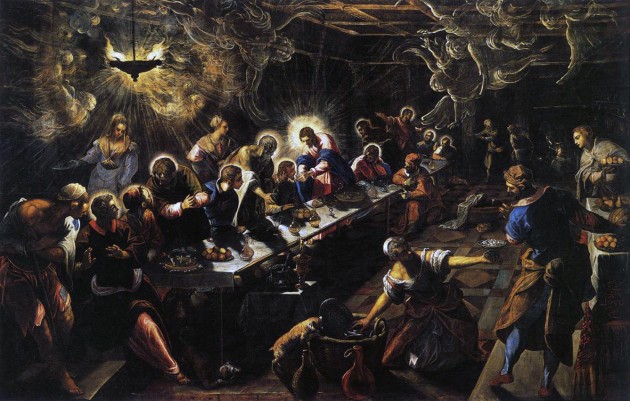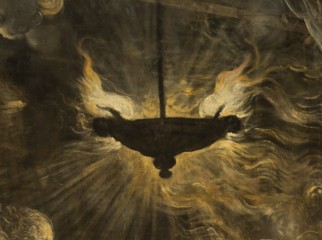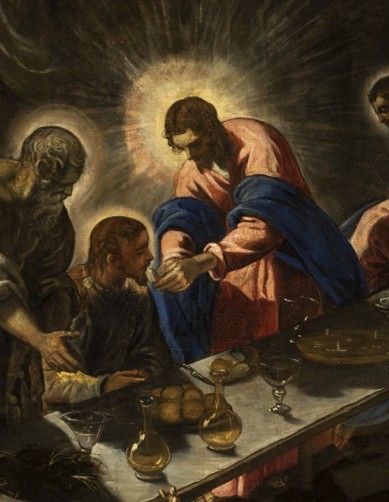To view this work of art on a smart board click here.

Jacopo Comin, who is known to us as Tintoretto, was born in Venice in 1518. He came by the name because his father was a fabric dyer (a tintore) and the young Jacopo, who started his painting vocation by daubing colors on the walls of his father’s workshop, was given the title “little dyer,” or tintoretto. He also acquired the title of “Il Furioso” for his “furious” and energetic approach to image making, which places him at the end of the High Renaissance into the style called Mannerism.
Tintoretto absorbed the influences of the Venetian artist, Titian, as well as the Renaissance powerhouse, Michelangelo. Tintoretto received the Venetian sense of rich, expressive color from Titian; he inherited the sense of dynamic figurative composition from Michelangelo. Tintoretto’s inventive mind added the elements of light, space and perspective, which are in great evidence in his late masterwork, The Last Supper, located in the church of San Giorgio Maggiore in Venice.
In 1594, the last year of his life, Tintoretto took on the subject of the Passover meal Jesus celebrated with his apostles the night before he died. It is a remarkable re-visioning of what had been a standard approach, as painted by Leonardo da Vinci. Tintoretto chose a different literal narrative and a different visual narrative in this masterwork. In doing so, he reset the focus in a way that stimulates the Catholic imagination.
Deeper and Deeper
The first thing we notice about the image is a sense of strangeness. Why are we not in that solemn room alone with the apostles and Our Lord? This place is like an inn with inattentive characters milling about. There are a dog and cat present, the cat poking his nose into a basket of dishes in the foreground. The room is deep and dark. The image seems tilted and off balance. The table in the Last Supper of Leonardo da Vinci had been perfectly level and even, parallel to the top and bottom edges of the image, but Tintoretto chose to angle the table and shoot it into the depths of the room. Rather than a classical, central vanishing point as seen in Leonardo’s version, the perspective leads us off to the side. The darkness obscures some things in shadow and a flaming lamp hanging from the ceiling brightly lights other things. This sense of apparent disarray and confusion marks this image as an example of Mannerism, which extended and amplified the exciting qualities of movement found in the artwork of Michelangelo. But is there meaning in Mannerism? The goal of the Mannerist artist is to use extreme forms to reveal extreme realities. Tintoretto’s design begins with the choice not to focus on the same narrative moment as Leonardo. Rather than the human drama of the announcement of Judas’ betrayal, Tintoretto has chosen the institution of the Eucharist as the dramatic peak of the meal.
Mannerism
Mannerism developed in the time of Protestant Revolution in the 16th century. Artists had grown interested in increasingly elaborate and sophisticated designs. Many of these Late Renaissance artists took their cue from Michelangelo. As seen in the Last Judgment and ceiling in the Sistine Chapel, Michelangelo’s figures were visually active: twisting, gesturing poses everywhere. Michelangelo found a rich source in ancient Greek sculpture, especially the image of Laocoön and his Sons being attacked by serpents. After the excommunication of Martin Luther in 1521, the Protestant Revolution set into motion a wave of iconoclasm in the North—destruction of Catholic churches and the images within. With few exceptions, the artists of Northern Europe began to serve the interests of Protestants, with images that downplayed the mystical dimension of the Faith, including the reality of the Eucharist. Altarpieces, crucifixes, haloes, ecstasies, and any visual reference to the true Presence were no longer desirable. The Council of Trent, convoked by Pope Paul III, attempted to form a response to the revolution. The result produced the Counter-Reformation, with significant implications for artists. Artists were encouraged to use images to truly convey the true faith. In some cases this meant taming down the sophistication and elaboration and focusing on a more “realist” approach that would be understandable by the non-artistic laity. However, rather than tone down the excitement, some Mannerists were able to use dynamic elements of design to inflame piety; Tintoretto was one of them.
Radical Design
 What are the ways Tintoretto signals to the viewer the importance of not just the historical night of the Last Supper but also the particular moment we are witnessing? The angled pitch of the table is distinctive. Tintoretto uses perspective to make the table penetrate into the darkness, but conversely it emerges from the darkness like an arrow shooting forward at us, adding a visual urgency. No matter where your eye starts in the image, you are guided from character to character by gestures, glances and movement. The extreme contrast of light and dark amplifies the drama of the moment. The design exudes the richness of chiaroscuro: the technique of using strong light and dark areas produced by a distinctive light source. The light source is actually two: the large, radiating halo of Jesus and the lamp from above. The apostles at the table possess haloes similar to Jesus, but smaller; the holiness of Jesus is imprinting on them. The lamp appears to be bursting forth with energy. The shape of this flaming source suggests two wings and a downward pointing beak. This is not difficult to interpret; it is a visual reference to the Holy Spirit illuminating the entire crowd, including the “cloud of witnesses,” semi-transparent and floating in the upper regions of the room.
What are the ways Tintoretto signals to the viewer the importance of not just the historical night of the Last Supper but also the particular moment we are witnessing? The angled pitch of the table is distinctive. Tintoretto uses perspective to make the table penetrate into the darkness, but conversely it emerges from the darkness like an arrow shooting forward at us, adding a visual urgency. No matter where your eye starts in the image, you are guided from character to character by gestures, glances and movement. The extreme contrast of light and dark amplifies the drama of the moment. The design exudes the richness of chiaroscuro: the technique of using strong light and dark areas produced by a distinctive light source. The light source is actually two: the large, radiating halo of Jesus and the lamp from above. The apostles at the table possess haloes similar to Jesus, but smaller; the holiness of Jesus is imprinting on them. The lamp appears to be bursting forth with energy. The shape of this flaming source suggests two wings and a downward pointing beak. This is not difficult to interpret; it is a visual reference to the Holy Spirit illuminating the entire crowd, including the “cloud of witnesses,” semi-transparent and floating in the upper regions of the room.
A Moment of Truth

What is this moment that produces these visual effects in the imagination of Tintoretto? Just as this normal room with servants, everyday bystanders, and animals are caught in the light and transformed with rich contrast, an unseen reality is being incarnated. By the fiery power of the Holy Spirit descending “like the dewfall” (as invoked in the epiclesis of the Divine Liturgy of the Mass), the room comes alive with a glistening sparkle; bread has been transformed into the Body of Christ and Jesus is distributing the Eucharist into the mouths of the Apostles. Ordinary room transformed; ordinary bread transformed. When we recite in the liturgy, “Lord I am not worthy that you should come under my roof, but only say the word and my soul shall be healed…” we acknowledge our hope that our diminished humanity will be overcome by the work of the Holy Spirit. Just as we are overshadowed and enlivened in our preparation for the Eucharist, this room in Tintoretto’s imagination has been reborn—it is no longer a common public house under an unworthy roof. The upper room has been transfigured by the presence of God both incarnate in Jesus and simultaneously incarnate in the Eucharist.
We can contemplate this by being reminded of the Preface-Canon from the Octave of Christmas. The prayer contains these lines:
…because by the mystery of the Word made flesh, the new light of Your glory shone upon the eyes of our mind; that while we acknowledge Him to be God seen by men, we may be drawn by Him to the love of things unseen.
This quote may have been in the mind of Tintoretto as he composed this image. In this painting, the artist reveals the unseen but real in the Eucharist, experienced at every Mass. As we “…prepare our hearts to celebrate these Sacred Mysteries…,” we are asked to be mindful that not only was the Word made flesh in the Incarnation, but the bread upon the Table of Sacrifice becomes the incarnate Body of Christ: body, blood, soul and divinity. While no visual image can ever truly convey the fullness of that reality, Tintoretto’s Last Supper may be one of the greatest attempts to dramatically convince us of that truth.
Linus Meldrum is Assistant Professor of Fine Arts at Franciscan University where he teaches the core curriculum course, Visual Arts and the Catholic Imagination, as well as Studio Art.
This article appeart on pages 21-24 of the printed edition.
Painting is in the public domain.
